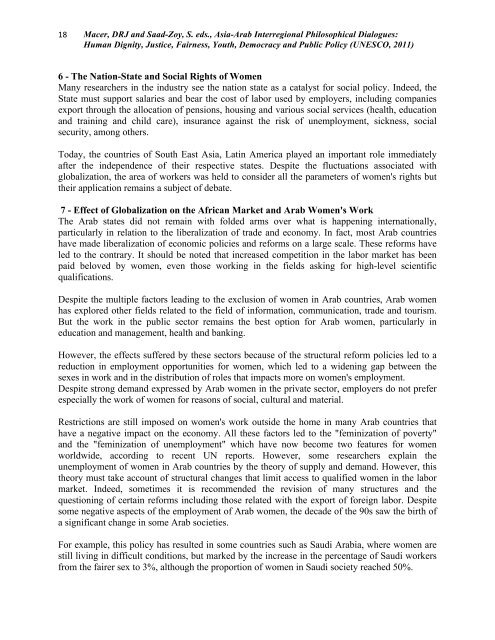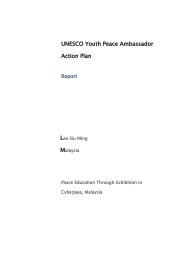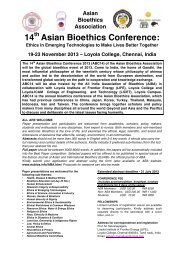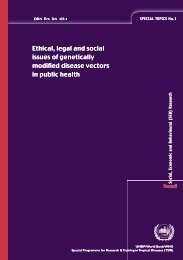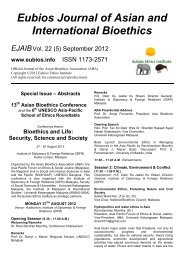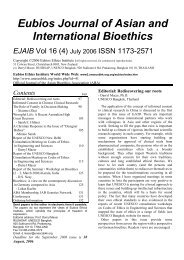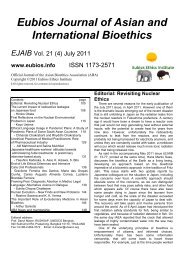Human Dignity, Justice, Fairness, Youth - Eubios Ethics Institute
Human Dignity, Justice, Fairness, Youth - Eubios Ethics Institute
Human Dignity, Justice, Fairness, Youth - Eubios Ethics Institute
Create successful ePaper yourself
Turn your PDF publications into a flip-book with our unique Google optimized e-Paper software.
18 <br />
Macer, DRJ and Saad-Zoy, S. eds., Asia-Arab Interregional Philosophical Dialogues:<br />
<strong>Human</strong> <strong>Dignity</strong>, <strong>Justice</strong>, <strong>Fairness</strong>, <strong>Youth</strong>, Democracy and Public Policy (UNESCO, 2011)<br />
6 - The Nation-State and Social Rights of Women<br />
Many researchers in the industry see the nation state as a catalyst for social policy. Indeed, the<br />
State must support salaries and bear the cost of labor used by employers, including companies<br />
export through the allocation of pensions, housing and various social services (health, education<br />
and training and child care), insurance against the risk of unemployment, sickness, social<br />
security, among others.<br />
Today, the countries of South East Asia, Latin America played an important role immediately<br />
after the independence of their respective states. Despite the fluctuations associated with<br />
globalization, the area of workers was held to consider all the parameters of women's rights but<br />
their application remains a subject of debate.<br />
7 - Effect of Globalization on the African Market and Arab Women's Work<br />
The Arab states did not remain with folded arms over what is happening internationally,<br />
particularly in relation to the liberalization of trade and economy. In fact, most Arab countries<br />
have made liberalization of economic policies and reforms on a large scale. These reforms have<br />
led to the contrary. It should be noted that increased competition in the labor market has been<br />
paid beloved by women, even those working in the fields asking for high-level scientific<br />
qualifications.<br />
Despite the multiple factors leading to the exclusion of women in Arab countries, Arab women<br />
has explored other fields related to the field of information, communication, trade and tourism.<br />
But the work in the public sector remains the best option for Arab women, particularly in<br />
education and management, health and banking.<br />
However, the effects suffered by these sectors because of the structural reform policies led to a<br />
reduction in employment opportunities for women, which led to a widening gap between the<br />
sexes in work and in the distribution of roles that impacts more on women's employment.<br />
Despite strong demand expressed by Arab women in the private sector, employers do not prefer<br />
especially the work of women for reasons of social, cultural and material.<br />
Restrictions are still imposed on women's work outside the home in many Arab countries that<br />
have a negative impact on the economy. All these factors led to the "feminization of poverty"<br />
and the "feminization of unemployment" which have now become two features for women<br />
worldwide, according to recent UN reports. However, some researchers explain the<br />
unemployment of women in Arab countries by the theory of supply and demand. However, this<br />
theory must take account of structural changes that limit access to qualified women in the labor<br />
market. Indeed, sometimes it is recommended the revision of many structures and the<br />
questioning of certain reforms including those related with the export of foreign labor. Despite<br />
some negative aspects of the employment of Arab women, the decade of the 90s saw the birth of<br />
a significant change in some Arab societies.<br />
For example, this policy has resulted in some countries such as Saudi Arabia, where women are<br />
still living in difficult conditions, but marked by the increase in the percentage of Saudi workers<br />
from the fairer sex to 3%, although the proportion of women in Saudi society reached 50%.


